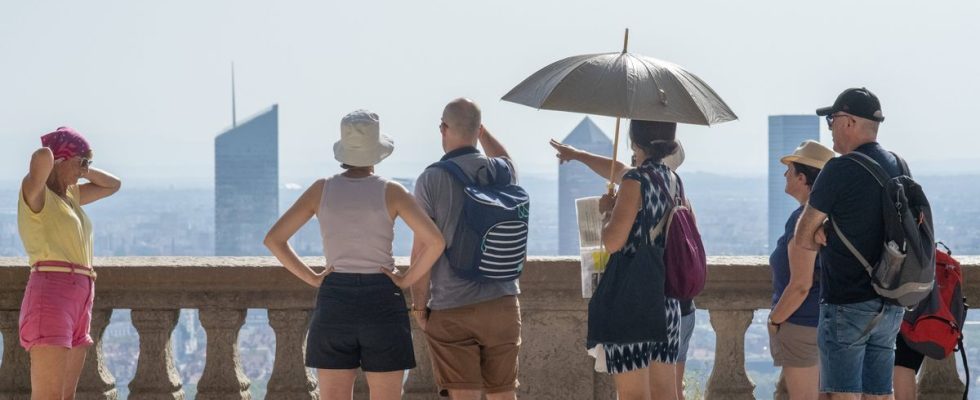On Tuesday, Christophe Béchu, Minister of Ecological Transition, invited elected officials and experts to draw up the third National Plan for Adaptation to Climate Change (PNACC) which must be presented “at the beginning of summer 2024”. These measures should prepare France for a rise in temperatures of around 4°C by 2100, as recalled by the results of scientific studies IF all countries keep their commitments.
So what will it be like to live in these conditions? For 20 minutesFrançoise Vimeux, climatologist atResearch Institute for Development and specialist in climate variability and evolution, has drawn up a portrait of what awaits us – well, what awaits especially the next generations – in the next seventy-six years.
How is a warming of 4°C on average annually illustrated in France?
To begin with, it should be remembered that this is an annual average. This means that, for example, summer will be 5°C hotter on average and that the heat waves we will experience will be 7 to 9°C hotter than those at the beginning of the 20th century. These phenomena will also be more numerous. It is estimated that the number of days of heat waves will increase globally fivefold by 2100.
Concretely, if we take the example of the city of Lyon, between 2041 and 2070, we will experience 40 days of heat waves on average per year, compared to ten days over the period 1976-2005. In addition to being more frequent throughout the territory, heat waves will be earlier and later in the season, arriving as early as May and continuing until October. We have already had this phenomenon in 2022.
We also know that there will be twice as many periods of drought as today. The Mediterranean rim, a very climatically sensitive region, will be particularly exposed because of the lack of rain that we will have during the summer. And during the winter, in the north of France, we will have a little more precipitation. Whether it is winter or summer, there will also be more and more torrential rains.
These figures are valid for a warming of 4°C, therefore, if all countries respect their commitments. It is possible that warming will be greater in 2100 and in this case, all phenomena will be amplified.
How can we explain these drought phenomena?
In summer, the way it rains will be different. We will have longer and longer periods without rain and when it does rain, it will be intense and brutal. In summary, a lot of rain in a short time. These rains will fall on dry soils. They will have difficulty infiltrating and will tend to run off. They will therefore not be effective in countering summer droughts in soils and vegetation.
If we take the example of the city of Lyon, between 2041 and 2070, we will experience 40 days of heat waves on average per year, compared to ten days over the period 1976-2005. »
How will human beings be able to live in these conditions?
Above all, we must remember that adaptation is a necessity. It’s not about living better, it’s just about living. Because a world at +4°C in France is a very different world from today. Our entire daily life will be turned upside down. Let’s take the example of heat waves again: they will arrive earlier, at a time when people are not on vacation and children will be at school. We therefore understand that the adaptation of cities to these phenomena is a major issue.
What are the solutions ?
We know the solutions. It’s the greening of cities. It’s replacing dark surfaces with white surfaces. It’s debiting. It’s better to thermally insulate buildings. We must also manage the health impact of such events on an aging population. The idea is not for everyone to have air conditioning, but to consider public buildings where we could take refuge when it gets too hot. It is also necessary to have available and efficient emergency services. Because, in 2100, this assistance may be requested at the same time to put out fires and respond to floods. We are already seeing at the moment, even though it is winter, simultaneous adverse weather phenomena in different regions. While the Pyrénées-Orientales are experiencing a monumental drought, Pas-de-Calais is completely flooded.
The solidarity of emergency services between regions in the face of exceptional events will no longer be possible if we do not increase their capacity.
What can we expect from Pnacc 3?
We can hope for a real adaptation project, bearing in mind that, at a minimum, warming will be +4°C in 2100. This must therefore be done in a scaled and differentiated manner depending on the territories. We must keep in mind what the climatic hazards will be in the regions, and which areas will be most exposed.
What we can also hope is that this plan will start immediately and effectively, because we are already very late in France. Even today, we have infrastructures that are built based on warming which would be +1.5°C or +2°C. These new constructions will meet the needs of the coming years but will no longer be suitable after 2050. However, we cannot carry out a renovation of all buildings every ten years.

